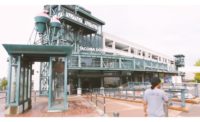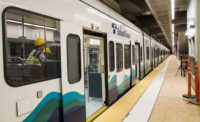ENR 2018 Top 25 Newsmakers
Ron Lewis: Being the Critical Link at One of Nation's Fastest-Growing Transit Agencies

Lewis (middle) inspects track installation inside a Sound Transit Northgate Link tunnel.
PHOTO COURTESY SOUND TRANSIT
Sound Transit opened its first light rail operation in the Seattle area in 2009. Now, in the midst of a voter-approved, 116-mile, $14-billion regional light rail program to be completed by 2041, Sound Transit—one of the country’s fastest-growing transit agencies—has systematically brought in projects on time and under budget, including almost 8 miles of tunnels.

A major contributor to that achievement is Ron Lewis, who has spent the last 20 years delivering successful projects at Sound Transit, from Airport Link to the $3.6-billion East Link Extension, Sound Transit’s largest project to date. Currently the agency’s executive director of design, engineering and construction management, Lewis says success requires flexibility, and collaboration from within the 1,000-employee agency and with stakeholders.
“I think our success starts well before construction,” he says. “We have well-planned projects. We have done our homework and taken care of the details, looking holistically at projects as early as possible.” Then, during construction, Lewis says collaborating with federal partners as well as contractors, designers, local jurisdictions and the community on an ongoing basis feeds relationships so that when issues arise, the group can readily work together to solve them.
In Bellevue, for example, Lewis says the designer, contractor and owner met daily to plan in detail that day’s activities. “We were thoughtful in planning and disciplined in execution,” he says. “Then we were flexible with means and methods. If something that wasn’t planned was encountered, we had the right people in the right places to make those calls in real time.”
“Ron’s politically astute, collaborative style of leadership allows the best decisions for the benefit of the project,” says Bob Adams, senior vice president of the Northwest for Guy F. Atkinson Construction. “Ron is willing to take risks when it saves time and money.”
Adams says that on the East Link extension, Lewis successfully negotiated challenging right-of-way agreements, and on the Bellevue tunnel he encouraged “out-of-the-box thinking that led to a number of design improvements and group decisions to keep the sequential excavation method on track as it encountered variable soil conditions.”
Lewis and Sound Transit are also flexible in their use of delivery methods, such as design-bid-build, design-build and GCCM, tailoring the model to the needs of the job based on technical specifications, physical work, politics, timing and schedule.




